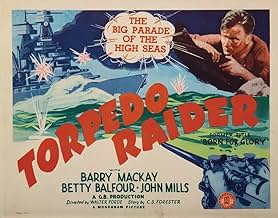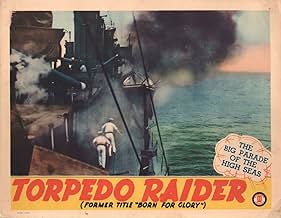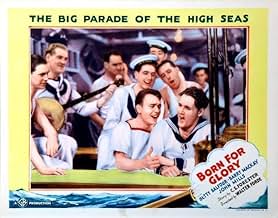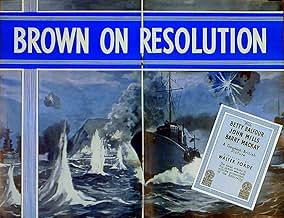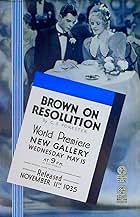NOTE IMDb
6,2/10
196
MA NOTE
Ajouter une intrigue dans votre langueIn 1914, after a German warship picks-up survivors from a sinking British warship it undergoes repairs off a deserted island but it faces sabotage attempts and attacks from one of the escape... Tout lireIn 1914, after a German warship picks-up survivors from a sinking British warship it undergoes repairs off a deserted island but it faces sabotage attempts and attacks from one of the escaped rescued sailors.In 1914, after a German warship picks-up survivors from a sinking British warship it undergoes repairs off a deserted island but it faces sabotage attempts and attacks from one of the escaped rescued sailors.
- Réalisation
- Scénario
- Casting principal
- Récompenses
- 1 victoire au total
Barry MacKay
- Lieut. Summerville
- (as Barry Mackay)
Avis à la une
"Born to Glory" is almost like two films in one. The first part, which is actually pretty much unnecessary, is about a simple sailor, Albert Brown (John Mills) meeting and marrying a woman. This portion is pleasant but not especially compelling. However, when Albert goes to to sea the film improves considerably...especially after war breaks out and Albert's ship is sunk by a German ship. He and what's left of the crew are taken prisoner by the same German ship...a ship damaged but not sunk in the encounter. Albert manages to escape and then wages a one man war on the Germans...shooting at them and harassing them as they try to repair their ship. It's all very exciting...and a great example of a simple individual rising to the occasion. Overall, this is a well made and inspiring film--one that gets better as the movie progresses.
In this, his first starring role in a movie during the course of a remarkable acting career that would span no less than seven decades, John Mills is perfectly cast as a plucky young sailor. This was the first of many heroic rolls that Mills would subsequently fill. In fact, for a while Mills played so many heroes that it was jokingly asserted that Britain could not have won World War II without him.
Originally entitled "Brown on Resolution", this movie is based upon a story by C. S. Forester, the author of the famous Horatio Hornblower novels. However, Like "The African Queen", which was also written by Forester, this naval yarn is set in the early days of World War I.
John Mills plays Albert Brown, a young Royal Navy seaman, the illegitimate son of a Royal Navy Officer who is not actually aware that he has a child at all. Assigned to an antiquated British cruiser in the Pacific, Brown's ship is sunk by a more powerful German warship early in World I. Rescued by the enemy warship, which puts into a lonely Pacific island for repairs, Brown steals a rifle and escapes ashore in an effort to keep the Germans pinned down long enough for his own Navy to arrive on the scene.
This is the sort of old-fashioned "Ripping Yarn" in which the lone hero pits himself against overwhelming odds for reasons of loyalty, duty and honor that would seem incomprehensible to people nowadays, but which struck a deep chord with audiences back then.
Incidentally, this film is also notable to naval history buffs due to the fact that the British Admiralty allowed the producers to use real warships that were in commission at the time. Among those are the battleship HMS Iron Duke, which was the flagship during the 1916 Battle of Jutland, and which was then still in service as a gunnery training ship. Also featured is one of five British light cruisers of the Leander class, all of which subsequently distinguished themselves during World War II, most particularly HMS Ajax and HMS Achilles, which would famously battle the German pocket battleship Graf Spee. Also of note, although for a very different reason, is the WW-I vintage light cruiser cruiser HMS Curacoa, which portrayed the German cruiser in the film. On the night of 2 October 1942 HMS Curacoa was sunk in a tragic collision with the passenger liner Queen Mary. The 80,000 ton liner literally sliced the elderly cruiser in half, like a hot knife through butter. However, the Queen Mary was unable to stop to help the survivors because she was transporting 10,000 badly-needed U.S. Army troops to Britain. For obvious reasons the tragedy had to be hushed up until after the war was over, even the 10,000 troops who were on board the Queen Mary at the time being sworn to secrecy. Although 101 crew members were eventually rescued by other escorting warships, 337 went down with HMS Curacoa,
Originally entitled "Brown on Resolution", this movie is based upon a story by C. S. Forester, the author of the famous Horatio Hornblower novels. However, Like "The African Queen", which was also written by Forester, this naval yarn is set in the early days of World War I.
John Mills plays Albert Brown, a young Royal Navy seaman, the illegitimate son of a Royal Navy Officer who is not actually aware that he has a child at all. Assigned to an antiquated British cruiser in the Pacific, Brown's ship is sunk by a more powerful German warship early in World I. Rescued by the enemy warship, which puts into a lonely Pacific island for repairs, Brown steals a rifle and escapes ashore in an effort to keep the Germans pinned down long enough for his own Navy to arrive on the scene.
This is the sort of old-fashioned "Ripping Yarn" in which the lone hero pits himself against overwhelming odds for reasons of loyalty, duty and honor that would seem incomprehensible to people nowadays, but which struck a deep chord with audiences back then.
Incidentally, this film is also notable to naval history buffs due to the fact that the British Admiralty allowed the producers to use real warships that were in commission at the time. Among those are the battleship HMS Iron Duke, which was the flagship during the 1916 Battle of Jutland, and which was then still in service as a gunnery training ship. Also featured is one of five British light cruisers of the Leander class, all of which subsequently distinguished themselves during World War II, most particularly HMS Ajax and HMS Achilles, which would famously battle the German pocket battleship Graf Spee. Also of note, although for a very different reason, is the WW-I vintage light cruiser cruiser HMS Curacoa, which portrayed the German cruiser in the film. On the night of 2 October 1942 HMS Curacoa was sunk in a tragic collision with the passenger liner Queen Mary. The 80,000 ton liner literally sliced the elderly cruiser in half, like a hot knife through butter. However, the Queen Mary was unable to stop to help the survivors because she was transporting 10,000 badly-needed U.S. Army troops to Britain. For obvious reasons the tragedy had to be hushed up until after the war was over, even the 10,000 troops who were on board the Queen Mary at the time being sworn to secrecy. Although 101 crew members were eventually rescued by other escorting warships, 337 went down with HMS Curacoa,
Notwithstanding the fact that 12 minutes has been edited out this is still an effective flag waver
C. S. Forester was wonderful at writing evocative seafaring yarns and this is one of his better stories. The film starts with couple of strangers who meet on a train and end up missing their connection and spending a few days together. Advance a few years and a powerful Nazi raider sinks a British warship and picks up the survivors. For one of them - "Albert Brown" (John Mills) the war isn't over and when the ship puts into a remote location to effect repairs, he steals a rifle and heads ashore from where he promptly takes pot shots at the repair crew. His plan is to delay the mending long enough for a pursuing Royal Navy flotilla to catch up and destroy the enemy ship. Walter Forde has assembled a strong cast of British actors - with a young Jimmy Hanley and Howard Marion-Crawford amongst them to keep the adventure moving along well, after a fairly slow start, that builds to an exciting denouement - and a question: could "Brown" be the result of that assignation many years earlier...?
This is a great film version of CS Forrestor's book of the same title.
I love the book and I love the movie.
Great story of determination in the face of long odds.
Brown one of two able seaman to survive a cruiser sinking after an engagement with a German cruiser is picked up by the damaged German cruiser.
The German cruiser needs repairs and chooses a bay on a rocky inhospitable island.
While the ship is immobile Borown steals a rifle and escapes ashore - he manages to snipe at the Germans repairing the ship for long enough for the rest of the British squadron to find and engage the German cruiser.
I love the book and I love the movie.
Great story of determination in the face of long odds.
Brown one of two able seaman to survive a cruiser sinking after an engagement with a German cruiser is picked up by the damaged German cruiser.
The German cruiser needs repairs and chooses a bay on a rocky inhospitable island.
While the ship is immobile Borown steals a rifle and escapes ashore - he manages to snipe at the Germans repairing the ship for long enough for the rest of the British squadron to find and engage the German cruiser.
Le saviez-vous
- AnecdotesAlthough Betty Balfour is first billed, her role has been so severely shortened in the surviving re-edited version, that very little footage of her still remains.
- GaffesIn the beginning, the ship shown to be in 1893 is a post 1910 made warship.
- Crédits fousOpening credits prologue: 11th July, 1893.
The opening of the Naval Exhibition at the Crystal Palace.
- ConnexionsVersion of Marin du roi (1953)
- Bandes originalesDanny Boy
(uncredited)
Traditional tune
Lyrics by Frederick Edward Weatherly
Performed by John Mills, Howard Marion-Crawford and sailors during the ship visit
Meilleurs choix
Connectez-vous pour évaluer et suivre la liste de favoris afin de recevoir des recommandations personnalisées
Détails
- Date de sortie
- Pays d’origine
- Langues
- Aussi connu sous le nom de
- Born for Glory
- Lieux de tournage
- Nare Head, Cornwall, Angleterre, Royaume-Uni(island sequences)
- Société de production
- Voir plus de crédits d'entreprise sur IMDbPro
- Durée
- 1h 20min(80 min)
- Couleur
- Rapport de forme
- 1.37 : 1
Contribuer à cette page
Suggérer une modification ou ajouter du contenu manquant

